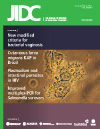Healthcare-associated infections among pediatric oncology patients in Pakistan: risk factors and outcome
DOI:
https://doi.org/10.3855/jidc.1705Keywords:
healthcare-associated infections, pediatric oncology patients, bloodstream infectionAbstract
Introduction: Pediatric oncology patients are at increased risk of contracting healthcare-associated infections (HAIs), which are responsible for increased morbidity and mortality rates as well as treatment costs. This study aimed to identify the frequency of HAIs among pediatric oncology patients and their outcome.
Methodology: Pediatric oncology patients admitted between January 2009 and June 2010 in a pediatric ward at Aga Khan University Hospital, Karachi, Pakistan, who developed HAIs, were analyzed.
Results: A total of 90 HAIs were identified in 32 patients in 70 admissions. The HAI rate among pediatric oncology patients was 3.1/100 admission episodes. Bloodstream infections (63 episodes, 90.0%) were the most common, followed by urinary tract infection (two episodes, 2.9%). Gram-positive infections were seen in 54 (60%) patients, followed by Gram-negative infection in 34 (37.8%), and fungi in 2 (2.8%) cases. Coagulase negative staphylococci was the most common Gram-positive and Escherichia coli and Pseudomonas aeruginosa were most common Gram-negative infections. Mortality rate among pediatric oncology patients who developed HAIs was 12.5% (4/32). Total parental nutrition use and length of stay longer than 30 days were the identified risk factors associated with increased mortality among pediatric oncology patients who developed HAIs.
Conclusion: We report an HAI rate among pediatric oncology patients of 3.1/100 admission episodes with a mortality rate of 12.5% in Pakistan. Further studies should be done, especially in the developing world, to identify the risk factors associated with increased mortality among pediatric oncology patients so that adequate measures can be taken to reduce the mortality among these patients.
Downloads
Published
How to Cite
Issue
Section
License
Authors who publish with this journal agree to the following terms:
- Authors retain copyright and grant the journal right of first publication with the work simultaneously licensed under a Creative Commons Attribution License that allows others to share the work with an acknowledgement of the work's authorship and initial publication in this journal.
- Authors are able to enter into separate, additional contractual arrangements for the non-exclusive distribution of the journal's published version of the work (e.g., post it to an institutional repository or publish it in a book), with an acknowledgement of its initial publication in this journal.
- Authors are permitted and encouraged to post their work online (e.g., in institutional repositories or on their website) prior to and during the submission process, as it can lead to productive exchanges, as well as earlier and greater citation of published work (See The Effect of Open Access).








